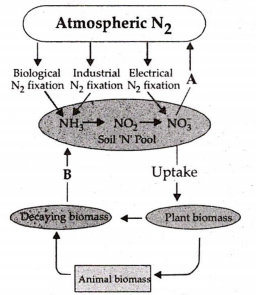 Multiple Choice Questions
Multiple Choice QuestionsIn the given diagram A and B represent

| A | B |
| Mineralisation | Demineralisation |
| A | B |
| Ammonification | Denitrification |
| A | B |
| Denitrification | Ammonification |
| A | B |
| Denitrification | Mineralisation |
Which of the following is correct set of micronutrient for plants?
Mg, Si, Fe, Cu, Ca
Cu, Fe, Zn, B, Mn
Mg, Fe, Zn, B, Mn
Mo, Zn, Cl, Mg, Ca
Leghaemoglobin helps in
imparting colour to floral petals
protecting nitrogenase from O2
destroying bacteria
transport of food in plants
Assertion : Plants absorb sulphur in the form of sulphate ions.
Reason : Sulphur bacteria are required for the formation of sulphate.
If both assertion and reason are true and reason is the correct explanation of assertion
If both assertion and reason are true but reason is not the correct explanation of assertion
If assertion is true but reason is false
If both assertion and reason are false
The function of leghaemoglobin during biological nitrogen fixation in root nodules of legumes is to
convert atmospheric N2 to NH3
convert ammonia to nitrite
transport oxygen for activity of nitrogenase
protect nitrogenase from oxygen
D.
protect nitrogenase from oxygen
Rhizobium is the nitrogen fixing bacteria present in root nodules of leguminous plants. Roots of a legume secrete chemical attractants flavonoids and betaines. Bacteria collect over the root hairs, release nod factors that causes curling of root hairs around the bacteria, degradations of cell wall and formation of an infection thread enclosing bacteria. The infected cortical cells differentiate and start dividing. It produces swelling of nodules and the infected cells enlarge. Bacteria stop dividing and form irregular polyhedral structures called bacteroids. The host cells develops a pinkish coloured pigment called leghaemoglobin. It is an oxygen scavenger and protects nitrogenase from oxygen. Symbiotic nitrogen fixation requires co-operations of 'Nod' genes of legumes, 'nod' 'nif' and 'fix' genes of bacteria.
